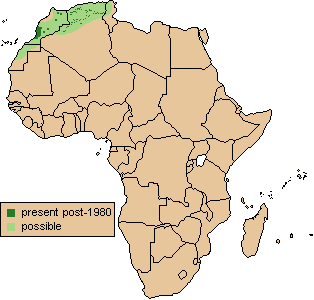Kingdom: |
Animalia Chordata Mammalia Artiodactyla Ruminantia Bovidae Antilopinae Antilopini Gazella |
Common name:
Scientific name:
Other names:
|
Cuvier's gazelle
Gazella cuvieri
Edmi gazelle, Edmi, Gazelle de Cuvier, Echtgazelle, Gacela de Cuvier
|
Physical Characteristics
-
Head and body length: 95-105 cm
- Shoulder height: 60-69 cm
- Tail length: 15-20 cm
- Adult weight: 20-35 kg (males), 15-20 kg (females)
- Shoulder height: 60-69 cm
Cuvier's gazelle has grayish-brown upper-parts, making it one of the darkest gazelles. A wide blackish band runs from the hind legs forward to the front legs, dividing the upperparts from the white belly. The rump is white and is bordered on each side by a narrow black stripe. The tail is thin and entirely black. Typical of gazelles, the face is striped: a dark line runs from the inside corner of the eye to the corner of mouth, bordered on top by a wider whitish stripe. A conspicuous black spot sits across the bridge of the nose. Both males and females have horns, although those of females are narrower and smoother. In both sexes, the horns are nearly straight, bending only slightly outwards and backwards. The bases of the horns in males are very heavily ridged. Typical horn length is 25-37 cm for males and 20-30 cm for females.
-
Similar species
- Among the gazelles, only the dorcas gazelle (Gazella dorcas) and slender-horned gazelle (Gazella leptoceros) have similar ranges. Both of these gazelles are much lighter in color compared to Cuvier's gazelle; their side stripes are faint and reddish instead of dark and blackish. The horns of the dorcas gazelle are more lyre-shaped, while those of the slender-horned gazelle are much longer.
Reproduction and Development
-
Gestation period: 160 days
- Litter size: 1 or 2.
- Sexual maturity: As early as 7 months (for females).
- Litter size: 1 or 2.
Most Cuvier's gazelles are born between March and May, although there is a second birthing season in October - these two periods have the most rainfall. Mothers will separate themselves from the herd prior to giving birth. At around one month old, infants will start eating solid food, although they will still nurse from their mothers.
Ecology and Behavior
-
Family group: Small mixed-sex groups with around four animals, sometimes
up to eight.
- Diet: Grasses, herbs, and leaves from shrubs.
- Main Predators: Jackals prey on young (other large predators have been exterminated).
- Diet: Grasses, herbs, and leaves from shrubs.
Habitat and Distribution

and Loggers et al., 1992 [Morocco])
Conservation Status
-
IUCN Red List: Endangered (2008)
- CITES Listing: Appendix I (2009).
- Threats: Overhunting by humans, habitat loss/degradation due to livestock grazing, agriculture, and charcoal production.
- CITES Listing: Appendix I (2009).
The global wild population of Cuvier's gazelles is estimated to be between 1,750 and 2,950 animals, most of which live in Morocco.






